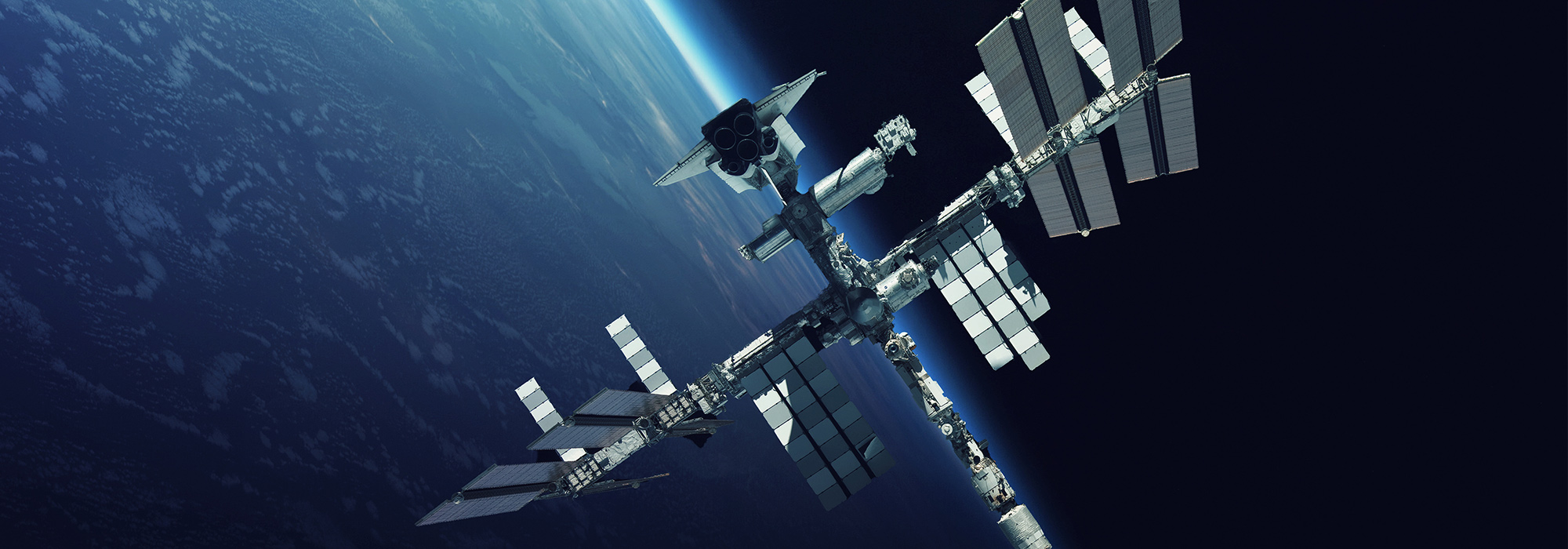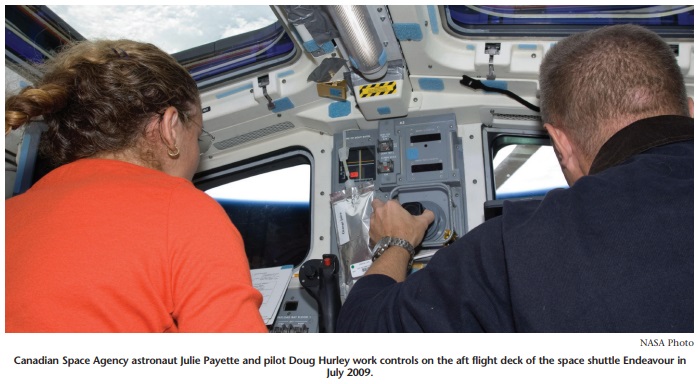
In July 2009, Robert Thirsk and Julie Payette spent 16 days together with other crew members on board the International Space Station (ISS). The presence of two Canadian astronauts in space at the same time symbolizes how successful our space program has been for a nation of our size. That impression was powerfully reinforced by the recent announcement that Canadian astronaut Chris Hadfield will captain the ISS for six months in 2010.
In space as in the G8, Canada punches above its weight, playing in the same league with much bigger and more powerful nations such as the United States, Russia, the United Kingdom, France and Japan. In that sense, Canada’s space program is an important adjunct to our traditional foreign policy goal of being not just a middle power, but an influential middle power with close ties to great powers.
Our efforts in space go back half a century. In 1962, Canada became the third country, following the USSR and the United States, to orbit a satellite — Alouette-1 Launched for us by the United States National Aeronautics and Space Administration (NASA) and still in orbit, Alouette-1 functioned for 10 years studying the ionosphere, thus helping pave the way for many additional satellites.
In July 1975, Canada’s National Research Council (NRC) signed an agreement with NASA to develop a robotic arm for its nascent space shuttle program. Thus was born the iconic Canadarm, first launched into orbit in 1981. But the Canadarm was not a one-off achievement. It signalled an ongoing relationship with NASA, in which Canada became both a paying and a playing partner. Indeed, paying and playing are inextricably linked. By investing in space technology in collaboration with NASA, Canada has exemplified the principle of leverage, earning a far bigger role in space exploration than it ever could have afforded on its own.
Developments have proliferated in multiple directions. The Canadarm has been succeeded by Canadarm2 as well as Dextre (the Dexterous Manipulator, or “space hand”) on the ISS, making Canada a world leader in space robotics. Similar technology has been employed on the Mars rovers for exploration of the red planet. And the benefits of robotics are not confined to space; the same Canadian technology is now being used for brain surgery at Foothills Hospital in Calgary. The robotic arm is superior to the human hand for delicate surgery because it is not subject to muscular tremors.
Another area of Canadian leadership is remote sensing technology. RADARSAT-1 (1995) and RADARSAT-2 (2007) scan the Earth 24 hours a day with microwaves rather than optical-wavelength radiation, thus providing a view unobstructed by weather, cloud formations or darkness of night. Such remote sensing has applications in many directions, such as monitoring all three of Canada’s coastlines for intruders, weather forecasting, observation of environmental change and exploration for subsurface mineral deposits. Canada could hardly pursue many of its key goals in national security and public policy without the support of satellite remote sensing. And then there are all the commercial applications of satellite communications technology that have become so much a part of modern life, such as bank machines, cellphones, satellite television and the Global Positioning System.
The benefits of robotics are not confined to space; the same Canadian technology is now being used for brain surgery at Foothills Hospital in Calgary. The robotic arm is superior to the human hand for delicate surgery because it is not subject to muscular tremors.
Yes, Canada has had a great run in space, but we are now coming to a cross-roads. In less than a year, the final space shuttle is scheduled to blast off for the International Space Station. The ISS, together with Canadarm2 and Dextre, will remain in orbit until 2020, but it will no longer be the focal point that it once was, and the shuttle’s Canadarm will soon become a museum piece.
On June 28, 2010, American President Barack Obama released his new National Space Policy. Beyond a modest funding increase of $6 billion over five years, Obama’s National Space Policy represents a distinctly new vision, as shown in its stated goals, which emphasize commercialization and globalization:
- Energize competitive domestic industries to participate in global markets and advance the development of: satellite manufacturing; satellite-based services; space launch; terrestrial applications; and increased entrepreneurship.
- Expand international cooperation on mutually beneficial space activities to: broaden and extend the benefits of space; further the peaceful use of space; and enhance collection and partnership in sharing of space-derived information.
- Strengthen stability in space through: domestic and international measures to promote safe and responsible operations in space; improved information collection and sharing for space object collision avoidance; protection of critical space systems and supporting infrastructures, with special attention to the critical interdependence of space and information systems; and strengthening measures to mitigate orbital debris.
- Increase assurance and resilience of mission-essential functions enabled by commercial, civil, scientific, and national security spacecraft and supporting infrastructure against disruption, degradation, and destruction, whether from environmental, mechanical, electronic, or hostile causes.
- Pursue human and robotic initiatives to develop innovative technologies, foster new industries, strengthen international partnerships, inspire our Nation and the world, increase humanity’s understanding of the Earth, enhance scientific discovery, and explore our solar system and the universe beyond.
- Improve space-based Earth and solar observation capabilities needed to conduct science, forecast terrestrial and near-Earth space weather, monitor climate and global change, manage natural resources, and support disaster response and recovery.
President Obama wants the agency to get out of the business of transporting astronauts back and forth to the ISS, hoping that the private sector can take over this function. He wants NASA to concentrate on developing technologies to propel robotic, and eventually manned, spacecraft to the Moon, Mars, asteroids and even beyond. He also cancelled current plans for the Constellation mission to return to the Moon, saying that it was hopelessly over budget and relied on old technology. We do not know yet whether Congress will accept all of the President’s plans; there has been stiff opposition from existing interests in major space states such as Florida, Texas, Alabama, California and Colorado. At the time of writing, debate about specifics was ongoing, but the broad policy-level framework initiated by Obama is clearly leading to change.
In any case, President Obama’s initiative brings Canada to a crossroads in space policy. In the past, we have prospered in close partnership with NASA and the United States, but the future is bound to be different. This will mean change, and the loss of some roles that we have filled in the past, but also enormous opportunities for future development.
As the orbital space around Earth is commercialized, Canada will have to start dealing with more private sector partners in addition to governments. Also, the public sector will be more globalized. Emerging economies such as China, India and Brazil are joining the former leaders, the United States and Russia, as major players. Still other advanced nations, such as France and Israel, are competing vigorously to sell their own technologies, often in areas where Canada has led in the past, such as robotics. As we continue to work with NASA and the United States, we will also have to learn to deal with all these new partners.
The new situation will be challenging, but also favourable to Canada if properly addressed. Our space program has excelled by concentrating on niches, especially in developing infrastructure, such as the Canadarm and Dextre, that can be adapted to many missions. We will need to build on this experience to extend our range of cooperation with an ever-widening range of private and public partners. And this new world of space policy will put demands on the Canadian government.
In the last 15 years, the policy situation in Canada could best be described as marking time. Recent funding for the Canadian Space Agency (CSA) has been static at about $300 million a year. Although the CSA has funded Earth observation satellites (RADARSAT-1, RADARSAT-2 and the soon-to-be-built RADARSAT Constellation mission), the overall policy framework has been weak; indeed, there has been no longterm space plan since 1994. The CSA went through a period of instability with the departure of Marc Garneau as president in 2006, though the appointment of former astronaut Steve MacLean as the new president in 2008 has improved that situation.
The CSA, however, is not an autonomous actor; it is dependent upon government appropriations and government approval of its plans. It is the government, therefore, that will have to grapple with the questions posed by the winding down of the ISS era and by President Obama’s new space plan. Does the government foresee a role for Canada in Obama’s new vision, emphasizing space exploration beyond low-level orbits and further out into our planetary system? Will we get in on the ground level as we did 35 years ago when the NRC undertook to develop the first Canadarm for NASA? Will we attempt to maintain the leading role in satellite communications, remote sensing and robotics that has generated a Canadian space industry with almost 7,000 highly paid workers distributed widely across the country?
Most crucially, will Canada continue with the pay-to-play model that has given us a role in space far beyond what we could have achieved on our own? Canada wisely concentrated its focus in certain areas, thus achieving the technological preeminence that made us indispensable to many NASA missions and generated all sorts of collateral benefits, such as putting eight Canadian astronauts into space. Canada can continue to reap the benefits of participating in the enormous American space program, but not for free; we will have to go on making strategic, well-calibrated investments proportional to our size. Our partnership with NASA should not be taken for granted; new competitors are lining up to replace us, should Canada not participate or fail to make a timely decision to participate. And at the same time, we will have to reach out to new partners as investment in space becomes both more commercialized and more globalized.
Canada’s overall fiscal position is sound, indeed better than that of any other country in the G8. Parliamentary Budget Officer Kevin Page is now projecting a return to balanced budgets by 2014-15, a year earlier than the Finance Minister had predicted in his March 2010 budget. The Conference Board of Canada says that a balanced budget may even be possible by 2013-14. Against this fiscal backdrop, it seems that Canada will be well able to continue making the investments in space technology and exploration that have helped make our space program a success story.
Photo: Shutterstock







